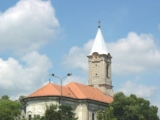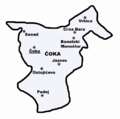
Coka
Encyclopedia

North Banat District
North Banat District is a northern district of Serbia. It lies in the regions of Banat and Bačka, in the autonomous province of Vojvodina. As of the 2002 census, the district has a population of 165,881. The seat of the district is Kikinda....
of Vojvodina
Vojvodina
Vojvodina, officially called Autonomous Province of Vojvodina is an autonomous province of Serbia. Its capital and largest city is Novi Sad...
, Serbia
Serbia
Serbia , officially the Republic of Serbia , is a landlocked country located at the crossroads of Central and Southeast Europe, covering the southern part of the Carpathian basin and the central part of the Balkans...
. The town has a population of 4,720, while Čoka municipality has 13,835 inhabitants.
History
The first written record about Čoka was made in 1247. It was part of a feudal tenure of which landowners were often changed. Later the settlement was abandoned due to the dense CumanCumans
The Cumans were Turkic nomadic people comprising the western branch of the Cuman-Kipchak confederation. After Mongol invasion , they decided to seek asylum in Hungary, and subsequently to Bulgaria...
incursions at the end of the 13th century, but it was rebuilt again in the 14th century. In 1552, it was under Ottoman
Ottoman Empire
The Ottoman EmpireIt was usually referred to as the "Ottoman Empire", the "Turkish Empire", the "Ottoman Caliphate" or more commonly "Turkey" by its contemporaries...
administration. At that time, it had a sparse population of 13 people, and at the end of the 16th century, the hamlet dwellers numbered 4 Serb
Serbs
The Serbs are a South Slavic ethnic group of the Balkans and southern Central Europe. Serbs are located mainly in Serbia, Montenegro and Bosnia and Herzegovina, and form a sizable minority in Croatia, the Republic of Macedonia and Slovenia. Likewise, Serbs are an officially recognized minority in...
families.
In the first half of the 18th century, the Ottoman administration was replaced by the Habsburg
Habsburg Monarchy
The Habsburg Monarchy covered the territories ruled by the junior Austrian branch of the House of Habsburg , and then by the successor House of Habsburg-Lorraine , between 1526 and 1867/1918. The Imperial capital was Vienna, except from 1583 to 1611, when it was moved to Prague...
one and according to 1717 data, there were 40 Serb
Serbs
The Serbs are a South Slavic ethnic group of the Balkans and southern Central Europe. Serbs are located mainly in Serbia, Montenegro and Bosnia and Herzegovina, and form a sizable minority in Croatia, the Republic of Macedonia and Slovenia. Likewise, Serbs are an officially recognized minority in...
houses in the village of which number increased to 192 until the middle of the 18th century, and in 1787, the number of population increased to 1,191 people. In 1796, the tenure owner Lőrinc Marcibányi had Hungarians settled here that Slovaks
Slovaks
The Slovaks, Slovak people, or Slovakians are a West Slavic people that primarily inhabit Slovakia and speak the Slovak language, which is closely related to the Czech language.Most Slovaks today live within the borders of the independent Slovakia...
followed then., which resulted in a rapid population growth and as early as the middle of the 19th century, the population numbered 2,739 people which increased to 4,239 until 1910. According to 1910 census, Hungarians were the dominant ethnic group in the village, while there existed a sizable ethnic Serb community as well.
As of 1918, Čoka is part of the Kingdom of Serbs, Croats and Slovenes (later renamed to Yugoslavia
Yugoslavia
Yugoslavia refers to three political entities that existed successively on the western part of the Balkans during most of the 20th century....
). Until the end of World War II
World War II
World War II, or the Second World War , was a global conflict lasting from 1939 to 1945, involving most of the world's nations—including all of the great powers—eventually forming two opposing military alliances: the Allies and the Axis...
, it was part of Novi Kneževac
Novi Kneževac
Novi Kneževac is a town and municipality in the North Banat District of Vojvodina, Serbia. The town has a population of 7,567, while the Novi Kneževac municipality has 12,952 inhabitants .-Name:...
municipality. Shortly afterwards, it became the seat of an own municipality, whereby it became an industrial centre of the region as well, receiving a large influx of new population. In 1991, it had a population of 5,244 people but In the next decade, the number of dwellers started to dwindle and 2002 census recorded only 4,707 people in the settlement.
Inhabited places
Čoka municipality includes the town of Čoka and seven villages. The villages are:- PadejPadejPadej is a village in Serbia. It is situated in the Čoka municipality, North Banat District, Vojvodina province. The village has a Hungarian ethnic majority and its population is 2,882 people .-External links:*...
(Hungarian: Padé) - JazovoJazovoJazovo is a village in Serbia. It is situated in the Čoka municipality, North Banat District, Vojvodina province. The village has a Hungarian ethnic majority and its population numbering 978 people .-External links:*...
(Hungarian: Hódegyháza) - Banatski MonoštorBanatski MonoštorBanatski Monoštor is a village in Serbia. It is situated in the Čoka municipality, in the North Banat District, Vojvodina province. The village has a Hungarian ethnic majority and its population numbering 135 people .-See also:*List of places in Serbia*List of cities, towns and villages in Vojvodina...
(Hungarian: Kanizsamonostor) - VrbicaVrbicaVrbica may refer to:Places:* Vrbica , a village near Bileća, Bosnia and Herzegovina* Vrbica , a village near Goražde, Bosnia and Herzegovina* Vrbica , a village near Jajce, Bosnia and Herzegovina...
(Hungarian: Egyházaskér) - Crna BaraCrna Bara (Coka)Crna Bara is a village in Serbia. It is situated in the Čoka municipality, North Banat District, Vojvodina province...
(Hungarian: Feketetó) - SanadSanad, SerbiaSanad is a village located in the Čoka municipality, in the North Banat District of Serbia. It is situated in the Autonomous Province of Vojvodina. The village has a Serb ethnic majority and its population numbering 1,314 people...
- OstojićevoOstojicevoOstojićevo is a village in Serbia. It is situated in the Čoka municipality, North Banat District, Vojvodina province. The village has a Serb ethnic majority and its population numbering 2,844 people with circa 300 Polish Silesian minority of Wisła descent .-References:*Slobodan Ćurčić, Broj...
Note: For the inhabited places with an absolute or relative Hungarian ethnic majority, the names are also given in Hungarian.
Municipality
The population of the Čoka municipality:- Hungarians = 7,133 (51.56%)
- SerbsSerbsThe Serbs are a South Slavic ethnic group of the Balkans and southern Central Europe. Serbs are located mainly in Serbia, Montenegro and Bosnia and Herzegovina, and form a sizable minority in Croatia, the Republic of Macedonia and Slovenia. Likewise, Serbs are an officially recognized minority in...
= 5,205 (37.63%) - Roma = 337 (2.43%)
- YugoslavsYugoslavsYugoslavs is a national designation used by a minority of South Slavs across the countries of the former Yugoslavia and in the diaspora...
= 228 (1.64%) - SlovaksSlovaksThe Slovaks, Slovak people, or Slovakians are a West Slavic people that primarily inhabit Slovakia and speak the Slovak language, which is closely related to the Czech language.Most Slovaks today live within the borders of the independent Slovakia...
= 201 (1.45%) - Others.
Five local communities have a Hungarian majority: Čoka, Padej, Jazovo, Banatski Monoštor, and Vrbica. Crna Bara has a relative Hungarian majority. Sanad and Ostojićevo have Serb majorities, although the latter has over 20% Hungarians, while Čoka, Padej and Crna Bara have over 20% Serbs.
Town
The population of the Čoka town:- Hungarians = 2,703 (57.43%)
- SerbsSerbsThe Serbs are a South Slavic ethnic group of the Balkans and southern Central Europe. Serbs are located mainly in Serbia, Montenegro and Bosnia and Herzegovina, and form a sizable minority in Croatia, the Republic of Macedonia and Slovenia. Likewise, Serbs are an officially recognized minority in...
= 1,541 (32.74%) - YugoslavsYugoslavsYugoslavs is a national designation used by a minority of South Slavs across the countries of the former Yugoslavia and in the diaspora...
= 98 (2.08%) - Roma = 48 (1.02%)
- Others.
Politics
Results of 2008 local elections in Čoka municipality: http://www.cesid.org/rezultati/sr_maj_2008-lokalni/index.jsp- Democratic PartyDemocratic Party (Serbia)The Democratic Party is a political party in Serbia. It is described as a social liberal or social democratic party.-Pre-war history:The Democratic Party was established on 16 February 1919 from unification of Sarajevo parties independent radicals, progressives, liberals and the Serbian part of...
(29.08%) - Hungarian CoalitionHungarian CoalitionThe Hungarian Coalition ; Serbian: Мађарска Коалиција , Mađarska Koalicija ) is a political coalition composed of 3 ethnic Hungarian political parties in Serbia: the Alliance of Vojvodina Hungarians, the Democratic Party of Vojvodina Hungarians, and the Democratic Fellowship of Vojvodina Hungarians...
(24.47%) - Serbian Radical PartySerbian Radical PartyThe Serbian Radical Party is a far-right Serbian nationalist political party in Serbia, founded in 1991. Currently the second-largest party in the Serbian National Assembly, it has branches in three of the nations that currently border Serbia – all former federal republics of Yugoslavia...
(17.16%) - Together for VojvodinaTogether for VojvodinaTogether for Vojvodina was a political coalition in the Serbian province of Vojvodina. At the latest legislative elections in Vojvodina, in September 2004, the alliance won 9.44 % of the popular vote, and 7 seats in the provincial parliament...
(6.88%)
Twin cities
DecsDecs
Decs is a village in Tolna County, Hungary.- External links :*...
, Hungary
Hungary
Hungary , officially the Republic of Hungary , is a landlocked country in Central Europe. It is situated in the Carpathian Basin and is bordered by Slovakia to the north, Ukraine and Romania to the east, Serbia and Croatia to the south, Slovenia to the southwest and Austria to the west. The...
Skala
Skala
Skała is a town in southern Poland, situated in the Lesser Poland Voivodeship , previously in Kraków Voivodeship ....
, Greece
Greece
Greece , officially the Hellenic Republic , and historically Hellas or the Republic of Greece in English, is a country in southeastern Europe....
Csanádpalota
Csanádpalota
Csanádpalota is a town in Csongrád county, in the Southern Great Plain region of southern Hungary.-Geography:It covers an area of and has a population of 3286 people ....
, Hungary
Hungary
Hungary , officially the Republic of Hungary , is a landlocked country in Central Europe. It is situated in the Carpathian Basin and is bordered by Slovakia to the north, Ukraine and Romania to the east, Serbia and Croatia to the south, Slovenia to the southwest and Austria to the west. The...

